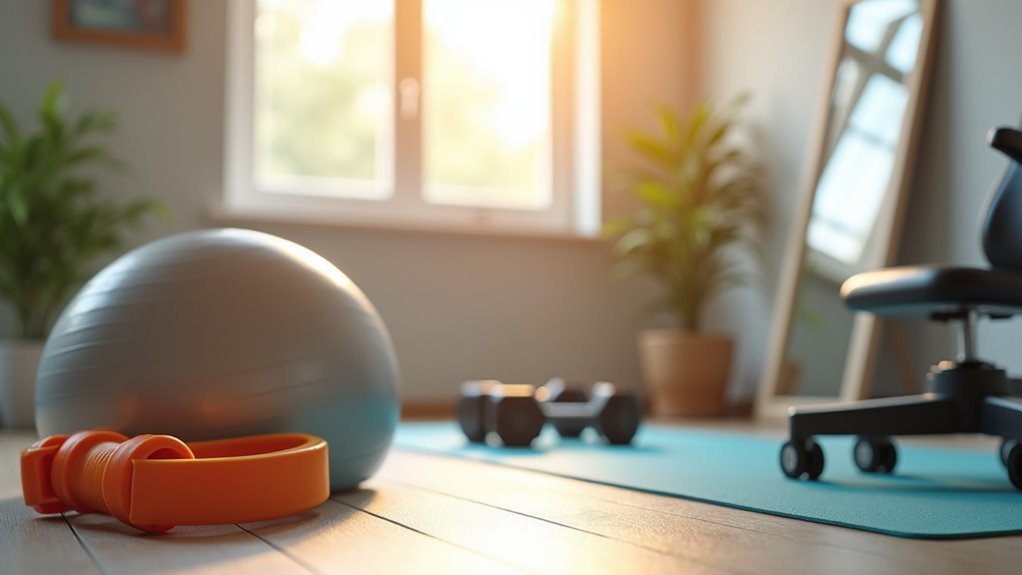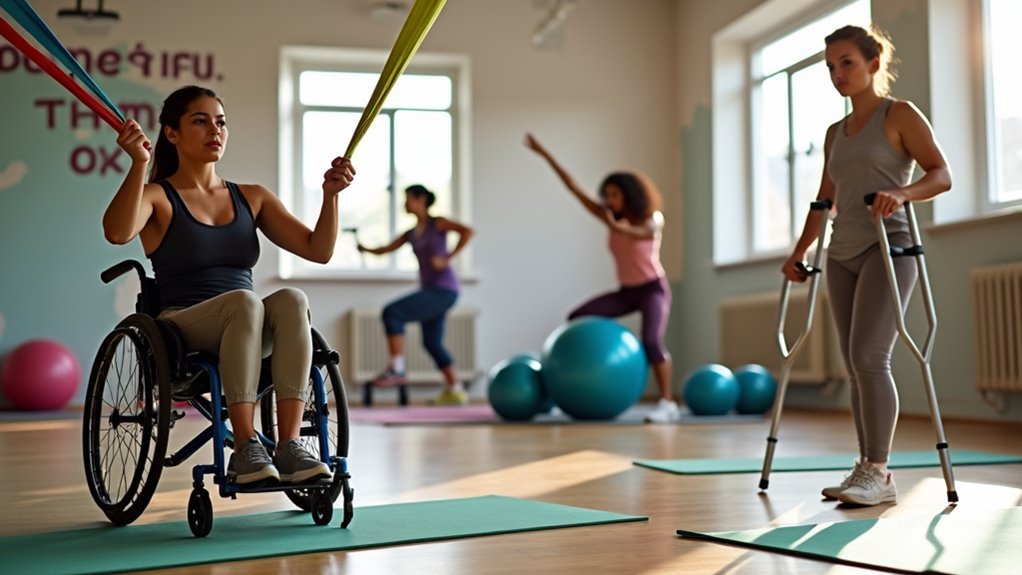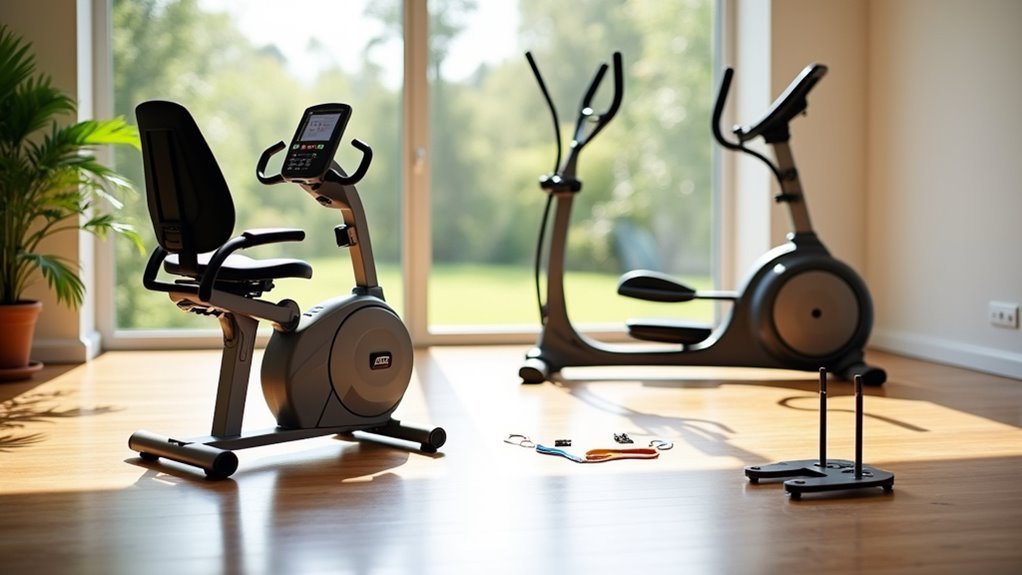You’ll transform your fitness routine with these ten powerful pool noodle exercises designed specifically for seniors. Start with seated noodle arm raises to build upper body strength, then progress to standing water walking for cardiovascular health. Try noodle paddle pull-throughs for core engagement, supine floats for hip flexibility, and figure-8 movements for coordination. Add seated leg lifts, resistance press-downs, gentle noodle biking, and full-body lunges with noodle presses to complete your workout. These exercises below offer detailed techniques for maximum benefits.
Seated Noodle Arm Raises for Upper Body Strength

Many seniors find that seated noodle arm raises offer an ideal starting point for building upper body strength without overwhelming their joints.
Start building upper body strength gently with seated noodle arm raises that protect your joints while delivering effective results.
You’ll grip the pool noodle with both hands and lift it to shoulder height while remaining seated. This exercise targets your shoulder and arm muscles effectively without excessive joint strain.
The seated position provides stability while you focus on proper form and controlled movements. You’ll notice improved coordination and balance as you practice these seated noodle arm raises regularly.
The low-impact nature makes them suitable regardless of your current fitness level, and you can modify the intensity based on your capabilities.
When performed in group settings, this exercise also creates opportunities for social interaction and community building.
Standing Water Walking With Noodle Support
When you’re ready to progress from seated exercises, standing water walking with noodle support offers an excellent next step for building lower body strength and cardiovascular endurance. You’ll hold the pool noodle horizontally across your body for stability while walking in shallow water. This technique lets you maintain proper posture and form while the water’s resistance strengthens your leg muscles.
| Benefit | Description |
|---|---|
| Joint Protection | Water buoyancy reduces stress on knees and hips |
| Enhanced Balance | Noodle support improves stability and coordination |
| Low Impact | Gentle resistance without jarring movements |
| Extended Duration | Less fatigue allows longer workout sessions |
Standing water walking with noodle support makes water exercises accessible and safe, encouraging you to stay active while building strength and improving mobility effectively.
Noodle Paddle Pull Through for Core Engagement

Six powerful muscle groups in your core activate simultaneously when you perform the Noodle Paddle Pull Through, making it one of the most effective water exercises for building central stability.
Six core muscle groups fire at once during the Noodle Paddle Pull Through, creating unmatched water-based stability training.
You’ll start by standing with feet hip-width apart, holding your pool noodle perpendicular to your body. Pull the noodle through the water while maintaining strong posture throughout the movement.
This low-impact exercise suits various fitness levels, letting you strengthen your core without joint strain.
You’ll notice improved balance and coordination as you incorporate the Noodle Paddle Pull Through into your regular routine. These enhanced skills help maintain independence in daily activities.
The exercise also supports rehabilitation efforts if you’re recovering from injuries or managing chronic conditions as part of extensive aquatic therapy.
Supine Noodle Float for Hip Flexibility
This gentle floating exercise transforms your hip flexibility while you relax in the water’s supportive embrace.
The supine noodle float involves wrapping your pool noodle around your upper body while lying back in the water, allowing your legs to extend naturally. This position alleviates spinal pressure while promoting deep hip relaxation.
You can perform this exercise in various water depths, making it perfect for your comfort level.
While floating, practice gentle hip abduction movements to strengthen your hip flexors and improve range of motion. The supine noodle float’s supported position helps maintain proper alignment without strain.
Regular practice enhances your balance and coordination over time, contributing to better overall mobility and physical health as you age gracefully.
Figure 8 Water Movements for Coordination

You’ll find the Figure 8 water movement particularly effective for enhancing your coordination and balance while providing a fun challenge in the pool.
Start by standing with your feet shoulder-width apart and grip a pool noodle with both hands, then draw smooth figure-eight patterns through the water at varying speeds and directions.
This dynamic exercise engages your core muscles while improving your proprioception, making it an excellent addition to your aquatic fitness routine.
Basic Figure 8 Technique
Although water exercises might seem simple, the Basic Figure 8 technique transforms your pool noodle into a powerful coordination tool that’ll challenge your balance and strengthen your core simultaneously.
Stand with feet shoulder-width apart and grip your pool noodle with both hands. Draw continuous figure-eight patterns in the water, engaging multiple muscle groups while improving stability. This low-impact movement reduces joint stress while promoting essential motor skills and spatial awareness.
| Benefit Category | Specific Advantage |
|---|---|
| Physical Strength | Enhanced core stability and muscle engagement |
| Joint Health | Low-impact exercise reducing stress on joints |
| Motor Skills | Improved coordination and spatial awareness |
| Social Wellness | Enjoyable group activity encouraging participation |
Pool Noodles make aquatic workouts engaging and effective, helping you maintain functional mobility while enjoying the social aspects of group exercise sessions.
Coordination Benefits Explained
Figure 8 movements with pool noodles create a neurological workout that goes far beyond simple muscle strengthening. When you draw figure eight patterns in water, you’re challenging your brain to coordinate simultaneous upper and lower body movements.
This complex coordination promotes neuroplasticity, encouraging your brain to form new connections that enhance overall motor skills. The exercise engages multiple muscle groups while water’s resistance provides effective strengthening without joint stress.
You’ll develop better balance and stability—essential for daily activities and fall prevention. Regular practice improves your proprioception, helping you better understand your body’s position and movement in space.
This enhanced spatial awareness translates to improved agility and coordination in everyday situations, making you more confident and steady on your feet.
Noodle Plank Hold for Balance Training
You’ll strengthen your core and improve stability by mastering the noodle plank hold, which challenges your balance while supporting your body weight in the water.
Start with proper plank form by positioning the noodle under your chest and extending your body horizontally while keeping your spine aligned.
As you become more comfortable, you can progress the balance challenge by reducing your grip on the noodle or adding gentle leg movements.
Proper Plank Form
Three key elements define proper noodle plank form: body alignment, breathing control, and strategic positioning in the water.
You’ll want to maintain a straight line from your head to your heels while gripping the pool noodle with both hands. Keep your core engaged and avoid letting your hips sag or pike upward. Position yourself in water that’s chest-deep for ideal resistance and support.
Focus on steady, controlled breathing throughout the hold. Don’t hold your breath, as this can create unnecessary tension. Your shoulders should stay directly above the noodle, and your feet can either touch the pool bottom or float behind you.
Start with 15-30 second holds and gradually increase duration as your strength improves. Proper plank form guarantees maximum benefit while protecting your joints from strain.
Balance Challenge Progressions
Once you’ve mastered basic plank positioning, you can advance your balance training through progressive noodle plank variations that challenge your stability in new ways. These water aerobics progressions systematically build your core strength while improving equilibrium control.
| Progression Level | Technique | Duration |
|---|---|---|
| Beginner | Both hands on noodle, shallow water | 15-30 seconds |
| Intermediate | Single arm alternating, medium depth | 30-45 seconds |
| Advanced | Eyes closed, deeper water position | 45-60 seconds |
Start by adjusting your noodle’s position—moving it further from your body increases difficulty. Progress to single-arm holds, alternating every ten seconds to challenge different muscle groups. Advanced practitioners can close their eyes or perform the exercise in deeper water, forcing greater core engagement and improved proprioception for enhanced fall prevention.
Seated Noodle Leg Lifts for Lower Body Toning
Balance and strength become increasingly important as we age, and seated noodle leg lifts offer an excellent way to target your lower body while maintaining stability.
Seated noodle leg lifts provide a stable, effective method for strengthening your lower body while improving balance as you age.
You’ll sit upright in a sturdy chair, holding your pool noodle horizontally at waist level. Lift one leg straight out while keeping your knee extended, then slowly lower it back down. This low-impact exercise strengthens and tones your leg muscles while promoting increased mobility.
Perform 10-15 repetitions on each leg to enhance muscle endurance and improve circulation in your lower extremities.
Seated noodle leg lifts are particularly beneficial if you have joint issues or you’re recovering from injury. Regular practice will improve your balance and coordination, which are essential for preventing falls and maintaining independence.
Noodle Press Down for Resistance Building
Press your pool noodle down into the water and discover one of the most effective resistance exercises for building lower body strength. The Noodle Press Down targets your hip and knee flexors while engaging your core for enhanced stability.
Form a U-shape with your noodle, then press it down beneath the water’s surface using controlled movements. As you release pressure, resist the noodle’s natural buoyancy to maximize muscle engagement.
You’ll find this exercise adapts perfectly to different water depths, making it ideal for nursing homes and senior fitness programs. The controlled resistance builds functional strength for daily activities while protecting your joints from impact stress.
Regular practice improves muscle tone and supports rehabilitation efforts effectively.
Gentle Noodle Biking for Cardiovascular Health
Transform your water workout into an enjoyable cardiovascular adventure with gentle noodle biking that strengthens your heart while protecting your joints.
Position yourself on a pool noodle and perform forward or backward pedaling motions to create an effective low-impact exercise that’s perfect for seniors with mobility concerns.
Noodle biking increases your heart rate without stressing your joints, making it an ideal cardiovascular workout. Regular practice enhances leg strength, coordination, and balance, improving your stability for daily activities.
A perfect heart-healthy exercise that builds strength and balance while keeping joints safe and comfortable.
You can easily adapt this exercise to different water depths, ensuring you’re comfortable and safe throughout your workout.
Consider joining group noodle biking sessions to foster community engagement and social interaction with fellow seniors while maintaining your fitness routine.
Lunge With Noodle Press for Full Body Conditioning
You’ll master the Lunge with Noodle Press by focusing on two essential components that work together for maximum effectiveness.
Proper lunge form creates the foundation for this full-body exercise, while correct noodle press technique adds the upper body conditioning element.
When you combine these movements correctly, you’ll engage multiple muscle groups simultaneously while improving your balance and coordination.
Proper Lunge Form
Mastering the lunge with noodle press requires attention to several key form elements that’ll maximize your workout benefits while keeping you safe.
Start by holding your pool noodle firmly above your head with both hands. Step back into your lunge position, making certain your front knee stays directly above your ankle and doesn’t extend beyond your toes. Keep your back straight and core engaged throughout the entire movement.
Your rear leg should form a straight line from hip to heel. Don’t let your torso lean forward or backward. Focus on controlled movement rather than speed.
This proper form guarantees you’re targeting your legs, core, and shoulders effectively while maintaining the balance and coordination benefits that make this lunge exercise particularly valuable for your fitness routine.
Noodle Press Technique
Once you’ve established proper lunge positioning, the noodle press technique transforms this foundational movement into a dynamic full-body exercise.
Hold the pool noodle above your head with both hands positioned shoulder-width apart. As you step back into your lunge, simultaneously press the noodle downward toward your front knee. This aquatic exercise engages your core, shoulders, and legs simultaneously, creating thorough muscle activation.
The pressing motion should be controlled and deliberate, maintaining your range of motion throughout the entire movement. You’ll feel your upper body working harder as water resistance challenges every muscle group.
This technique adapts easily to your individual health goals by adjusting lunge depth or pressing intensity, making it perfect for building strength while improving balance and stability.
Frequently Asked Questions
What Is the Senior Exercise With Pool Noodles?
You’ll perform low-impact water exercises using pool noodles for buoyancy and resistance. These include noodle paddle pulls, water biking, and lunges that improve your strength, balance, and coordination safely.
Is Pool Exercise Good for Seniors?
You’ll find pool exercise excellent for senior fitness because it’s low-impact, reducing joint stress while improving strength, balance, and cardiovascular health. It’s adaptable to different fitness levels and promotes social interaction.
What Exercise Burns the Most Belly Fat in the Pool?
You’ll burn the most belly fat with high-intensity interval training using pool noodles for resistance. Alternate between intense noodle exercises and recovery periods to boost your metabolic rate and maximize fat loss.
What Is the Most Beneficial Exercise for Seniors?
You’ll benefit most from low-impact exercises that combine strength training, balance work, and cardiovascular activity. These movements help you maintain independence, prevent falls, and improve your overall physical and mental well-being effectively.
In Summary
You’ve discovered nine fantastic pool noodle exercises that’ll transform your fitness routine. These low-impact movements provide excellent resistance training while protecting your joints from stress. Start slowly with 2-3 exercises per session and gradually build your endurance. Remember to maintain proper form and listen to your body’s signals. With consistent practice, you’ll notice improved strength, balance, and flexibility. Your pool noodle isn’t just a fun float—it’s your pathway to better health and well-being.





Leave a Reply